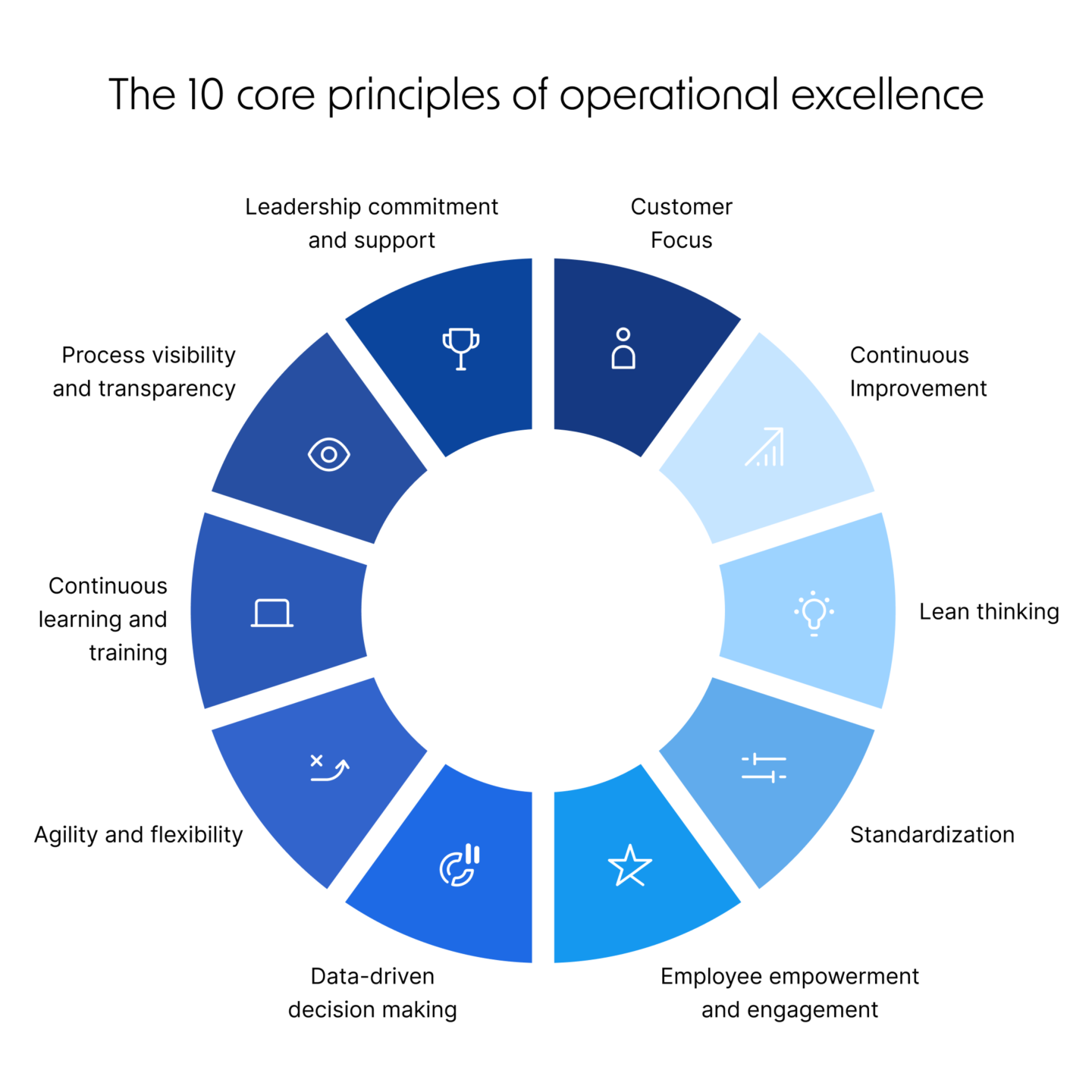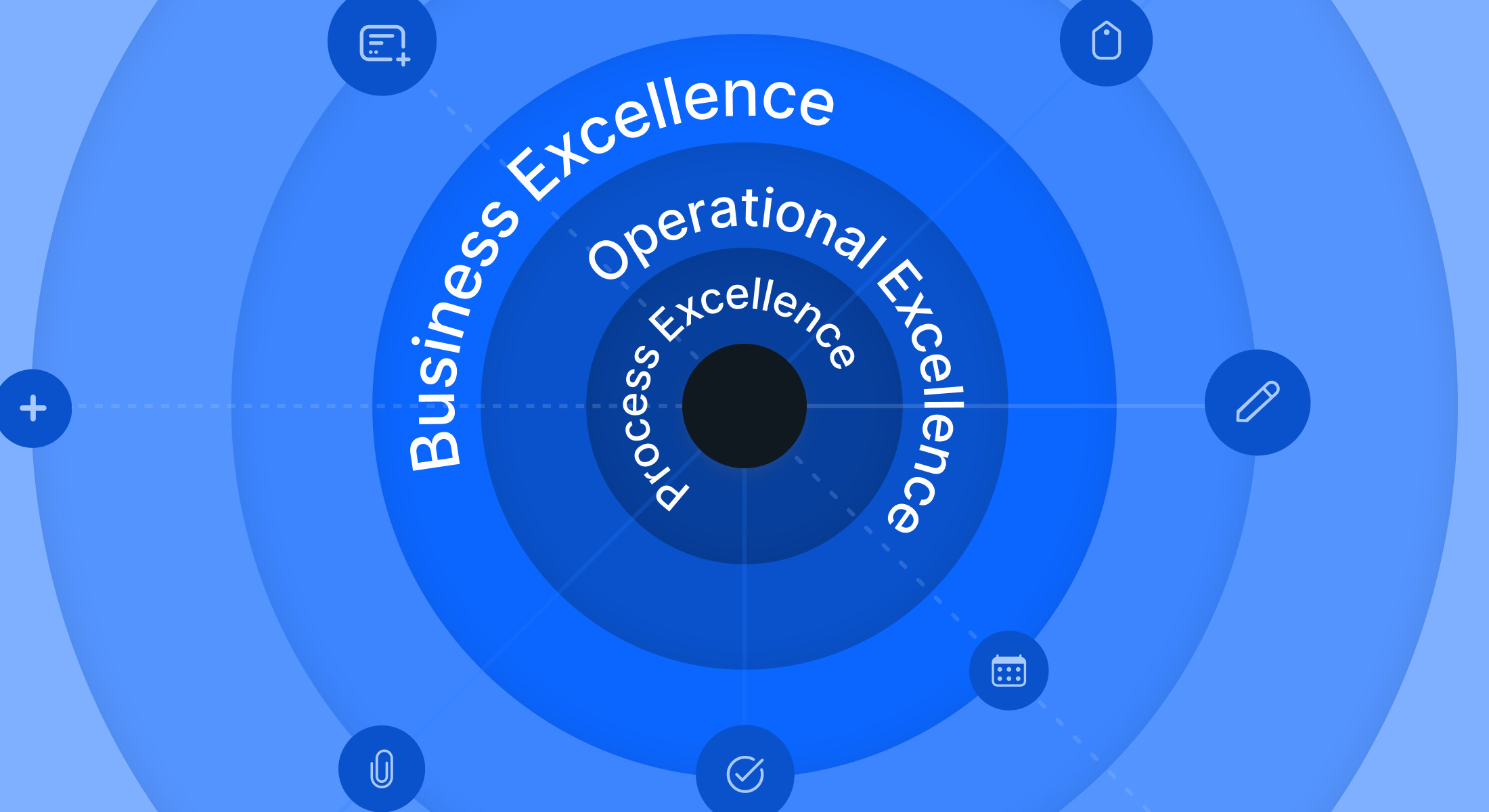
Operational excellence is one of the most important (and confusing) terms in the business world. Every company wants to achieve it, but what does that really look like? What are the tactics? And most importantly, what happens next?
In this post, we’ll define operational excellence, illustrate it with examples, and explain how it’s different from similar terms like business excellence and process excellence. We’ll also show you some of the tactics companies use to successfully reach the point of operational excellence.
The IT Guide to Workflow Management
Easily build and automate any workflow for any team.

What is operational excellence?
To put it simply, operational excellence means creating a business that outperforms the competition by doing things better than your competitors. Or, as business writer Michael Sony puts it, operational excellence is “making improvements to attain a competitive advantage.” But that’s a high-level definition, so let’s add a little more detail.
In their 1992 article “Customer Intimacy and Other Value Disciplines,” business experts Michael Treacy and Fred Wiersema define operational excellence as:
“A specific strategic approach to the production and delivery of products and services…[that aims to] minimize overhead costs, to eliminate intermediate production steps, to reduce transaction and other ‘friction’ costs, and to optimize business processes across functional and organizational boundaries.”
Despite these two definitions for operational excellence, one simple and one more complex, neither quite tells the whole story. To get to the core principles of this term, let’s build on these definitions by breaking it apart and looking at each word separately.
What are operations?
Operations are the activities that take place within a business and help businesses achieve their goals and sustainable growth. Operations is a broad category that can refer to anything that keeps the business running.
In general, operations do at least one of the following:
- Drive revenue
- Create value for customers
- Deliver services
- Departments or processes that support any of the items above, like:
- HR
- Finance
- Marketing
- Sales
- IT
- Legal
- Facilities management
In this context, operations is a broad category that refers to any activities that happen in the business. This means that efforts or strategies developed to achieve overall operational excellence are usually more focused and applied within specific departments or teams.
Learn more about the different types of business processes and how they relate to business operations.
What is excellence?
Now that we’ve defined operations, let’s tackle the second part of the term: excellence.
In the context of business operations, excellence may refer to how well a business:
- Does things better than competitors
- Does things better than they were done previously
- Minimizes waste or repetition
- Identifies and solves problems quickly
- Minimizes or eliminates errors
- Continually improves the way things are done
- Maximizes employee productivity
- Creates better user experiences
Keep in mind that excellence does not mean “perfection.” It simply means doing things in a way that makes the best use of available resources at the time and maintaining a culture of continuous improvement to build on previous successes and adapt to evolving business needs.
Where did the idea of operational excellence come from?
Operational excellence is a concept developed by Dr. Joseph Juran in the 1970s. At the time, Juran was helping business leaders in Japan learn how to create stronger and more competitive businesses.
Initially, the concept of operational excellence was applied mostly to manufacturing processes. Dr. Juran’s work was the basis for the Shingo Model, which is a framework for achieving it.
The 10 core principles of operational excellence
To achieve high levels of performance, effectiveness, and competitiveness, operational excellence must be built upon a set of core principles. These principles foster a culture of continuous improvement, innovation, and customer-centricity. Although there are various frameworks and methodologies, the following are some fundamental core principles of operational excellence:

Customer focus
Putting the customer at the center of all operations is crucial. Understanding customer needs, preferences, and expectations allows organizations to align their efforts to deliver exceptional value and superior experiences.
Continuous improvement
Operational excellence is a journey, not a destination. Embracing a philosophy of continuous improvement means constantly seeking opportunities to enhance processes, eliminate waste, and optimize performance. Encouraging employees to provide feedback and contribute ideas for improvement is essential.
Lean thinking
The concept of “lean thinking” involves eliminating non-value-added activities, processes, and resources to streamline operations and improve efficiency. This principle aims to maximize value delivery while minimizing waste, unnecessary steps, and delays.
Standardization
Process standardization refers to processes and workflows that occur the same way each time and produce consistent results. Standardized processes foster consistency, reduce variations in output, and ensures that everyone follows proven methods for accomplishing tasks. Standardization improves efficiency and makes it easier to identify and address potential issues.
Employee empowerment and engagement
Empowering employees with the autonomy to make decisions and take ownership of their work fosters a sense of responsibility and accountability. Engaged employees are more likely to contribute their best efforts and actively participate in process improvements.
Data-driven decision making
Operational excellence relies on data to make informed decisions. Collecting and analyzing relevant data enables organizations to identify areas for improvement, measure progress, and base decisions on evidence rather than assumptions.
Agility and flexibility
The business landscape is constantly evolving, and operational excellence requires organizations to be agile and adaptable. Being able to respond quickly to changes in the market, technology, or customer needs is essential for staying competitive.
Continuous learning and training
Encouraging a culture of continuous learning and providing employees with relevant training ensures that they have the skills and knowledge needed to excel in their roles and contribute to continuous process improvements.
Process visibility and transparency
Operational excellence thrives on transparency. Ensuring that processes are visible and accessible to all relevant stakeholders allows for better collaboration, accountability, and understanding of how different activities contribute to overall performance.
Leadership commitment and support
Leaders play a critical role in driving operational excellence. Their commitment, support, and active participation in improvement initiatives set the tone for the entire organization and demonstrate the importance of continuous improvement as a core value.
Operational excellence example
The concept of operational excellence might seem a bit abstract, so let’s look at a concrete example. To make it more meaningful, let’s consider what operational excellence looks like in a typical procurement department that manages a wide range of complex and interconnected processes. For now, let’s focus on just one: purchasing.
The purchasing process is common to practically every business, and is responsible for fulfilling or arranging payment for the goods and services a business needs to operate. This process includes approving purchase requests, creating purchase orders, and identifying cost-saving opportunities. Here’s an example of a typical purchasing process.

Operational excellence in this scenario could include reviewing each step of the process through both quantitative and qualitative lenses. For example, it would try to address issues related to:
- Waste
- Errors
- Efficiency
- Process structure
- User experiences (for both requester and process owner)
- Unnecessary delays
- Overall process performance
- Information or collaboration silos
- Quality of materials and services purchased
- How well the process is aligned with business strategy
- Understanding how this process is related to other finance team processes
In this example, operations excellence would be achieved by:
- Creating a structured process
- Having a thorough understanding of the process flow
- Determining KPIs and benchmarks, then measuring them
- Evaluating the process for improvement opportunities
- Implementing an optimized version of the process
- Repeating this cycle on a regular cadence
Operational excellence vs. continuous improvement
Based on the example above, it may start to sound as though operational excellence and continuous improvement are the same thing. But that’s not quite true. Continuous improvement is just one component of operational excellence.
Continuous improvement aims to identify the immediate and discrete changes that need to be made to keep a business competitive. By regularly evaluating processes, workflows, and ongoing projects, teams get a better understanding of why something that might have worked at one time no longer delivers the desired result.
Business goals and customer expectations evolve over time, and internal processes have to change to keep in step. Otherwise, a gap between what a process does and what it should do emerges.
Operational excellence is a broader strategy that shapes long-term growth, impacts company culture, and focuses on sustainable solutions.

Process excellence vs. operational excellence
While both disciplines aim to produce excellence, process and operational excellence differ in their scope.
Process excellence zeros in on a single process or workflow. Isolating the process makes it easier to dig more deeply into one area of work, and then solve problems within that specific area. Operational excellence includes process excellence initiatives, but it also considers the relationships between different processes.
For example, a finance team may have an overarching goal of attaining operational excellence across the department. Part of this effort includes tasking the managers of different processes — such as procurement, accounts payable, accounts receivable, and expense reimbursement — with optimizing their individual processes.
Once each process is optimized, an operational excellence perspective would look at how those processes impact each other, how data is shared between them, and whether or not there are instances of duplicate work or waste. It also aims to address process gaps, dissolve silos, and solve the new process problems that occur when new apps and systems are integrated into the tech stack. We call this stack extensibility.
Learn more about process excellence.
Operational excellence vs. operational efficiency
In summary, operational excellence and operational efficiency are two critical components of effective business management. While operational efficiency focuses on refining processes to maximize productivity and cost savings, operational excellence goes beyond efficiency to embrace continuous improvement, innovation, customer-centricity, and strategic alignment.
These concepts are intertwined and play a key role in driving business success. Organizations need to comprehend these differences to make informed decisions and implement strategies that enhance their business performance and create a lasting impact in their industries.
Business excellence vs. operational excellence
Another term that sometimes gets confused with operational excellence is business excellence. In both cases, the tactics and goals are the same, but once again the focus area is different. Business excellence is concerned with how the business develops its operations strategy, its relationship to competitors, and how well it achieves its targets.
Business excellence includes any efforts or high-level decisions that impact a business as a player in a market, such as how to manage stock, how to define the brand, how and where to advertise, and its approach to product development.
Why is operational excellence important?
Striving for operational excellence helps a business stay competitive by delivering the most value to its customers. When waste and redundancies are eliminated, those resources can be channeled back to the customers as additional value hence improving the customer experience.
Another way to answer this question is to think about the value disciplines model. According to Treacy and Wiersema, market-leading companies excel in one of three value disciplines:
- Operational excellence
- Customer intimacy
- Product leadership
These market leaders meet the industry standards for the other two value disciplines, but they only excel at one. Why is this important? Because by narrowing their priority focus to a single value discipline, they are able to compete more effectively and exceed customer expectations.
For example:
- Apple is a company that’s known as a product leader because of its focus on innovation and the high-quality standards for its products.
- Amazon is known as a leader in operational excellence because they have made online shopping fast, easy, and convenient.
- Lowe’s is an example of a company that emphasizes customer intimacy by working closely with customers to ensure that they get the right products and knowledge to complete their home improvement projects. Lowe’s employees spend time with their customers in order to truly understand their needs and provide guidance on their projects. And, yes, to sell them the materials they need to meet their goals.
Operational excellence is important because it’s one of three competitive levers each business has to pull, and can be a way a company differentiates itself from its competitors.
How to achieve operational excellence
Achieving excellence takes operational planning, resources, and work. The good news is that it’s within reach for any company with a few different methods.
Shingo Model
According to the Shingo Institute, this model is designed for “building a sustainable organizational culture of excellence.” The Shingo Model emphasizes the importance of understanding not only how organizational excellence is achieved, but why.
With this model, operational excellence is best understood by breaking each system down into smaller parts. It also focuses on identifying the right KPIs and leading indicators to measure success.This deep understanding of organizational excellence is achieved by following the Shingo Model’s guiding principles.
10 Guiding Principles of the Shingo Model
| Principle | Business application |
| Respect every individual | Investing in building relationships based on mutual trust with your employees |
| Lead with humility | Being willing to listen to those who understand the problems and processes better than you |
| Seek perfection | Aiming for the best result you can imagine |
| Embrace scientific thinking | Experimenting, observing, learning, and repeating |
| Focus on process | Understanding that the quality of the process determines the quality of the results |
| Assure quality at the source | Avoiding problems later by solving problems as early as possible in the process |
| Improve flow and pull | Studying and understanding customer demand, and then delivering value that meets it perfectly |
| Think systemically | Looking at the big picture Dissolving silos, distributing information, and making sure everyone understands their goals |
| Create constancy of purpose | Communicating business strategy, identity, and direction to everyone in the company Being transparent |
| Create value for the customer | Recognizing that value must be defined through the lens of what a customer wants and is willing to pay for |
Lean
In short, the lean management model aims to reduce the amount of waste in a process to zero and deliver perfect customer value. The characteristics of the lean model are closely related to those of the Shingo model (as both are based on the work of engineering expert Shigeo Shingo) and were similarly first applied to the automotive production process.
The term “lean” is attributed to John Krafcik, who developed the term in his 1988 article “Triumph of the Lean Production System.” The system was further developed in the book “Lean Thinking: Banish Waste and Create Wealth in Your Corporation” by James Womack and Daniel Jones. According to them, the key concepts involved in lean thinking include:
- Value stream. This includes all the tasks, actions, and workflows required to bring a product to completion.
- Flow. This is the relationship and momentum between all the elements of the value stream.
- Pull. The ability to create exactly what the customer wants, exactly when they want it.
- Transparency. This ensures that everyone involved in the value stream has access to all the information they need.
- Perfection. The relentless pursuit of incremental improvements.
Kaizen
A third approach to operational excellence is also related to the Shingo Model and to lean management. This is kaizen, a Japanese word that means something like “continual change for the better.”
According to the Kaizen Institute, this approach to operational excellence is built on five principles:
- Understand the customer in order to create value.
- Eliminate waste at every opportunity.
- Engage change where work happens.
- Be transparent and data driven.
- Empower people.
Kaizen methodology was originally applied to assembly lines in auto manufacturing, but its principles have since been applied to a broad range of initiatives and activities.
Six Sigma
Of the different approaches to operational excellence, Six Sigma is the most recently developed. It was developed in the 1980s by Bill Smith, an American engineer working at Motorola. Six Sigma focuses on minimizing or eliminating variance in processes. Because it refers to the standard deviation arch of a normal distribution model, this is how the approach gets its name.
The primary Six Sigma methodology is called “DMAIC.” This is an acronym for a structured five-step problem-solving approach that breaks down each of the steps into a series of tasks and deliverables. Here is a summary of the DMAIC method:
- Define. Identify the problem, all stakeholders, the customer value, and the plan for sustainable improvement.
- Measure. Determine key metrics and validate their measurements.
- Analyze. Find the causes of the inefficiency or problems with the process.
- Improve. Develop and implement a solution plan.
- Control. Build in processes and standards to enforce the newly optimized process.
It’s important to note one key difference between Six Sigma and Lean. Six Sigma focuses on eliminating variance from a process; lean prioritizes reducing waste.
How to measure operational excellence
Measuring operational excellence involves a comprehensive evaluation of various aspects within an organization to ensure that processes, systems, and strategies are optimized for maximum efficiency, effectiveness, and value delivery. Here’s a more detailed explanation of how you can measure operational excellence:
Process efficiency
Evaluate how well processes perform in terms of speed, accuracy, process efficiency, and resource utilization. Analyze cycle times, lead times, and throughput to identify bottlenecks or areas for improvement.
Quality and defect rate
Monitor the quality of products or services delivered to customers. Ensure consistent high-quality outcomes by monitoring defect rates, error rates, and rework levels.
Cost-effectiveness
Analyze the financial efficiency of processes by assessing costs, resource allocation, and waste reduction efforts. This can include direct costs, indirect costs, and cost-per-unit metrics.
Customer satisfaction
Gauge customer satisfaction by collecting feedback, conducting surveys, and analyzing customer complaints. Common indicators include Net Promoter Score (NPS) and Customer Satisfaction Score (CSAT).
Employee engagement
Evaluate employee satisfaction, motivation, and commitment by conducting surveys, feedback sessions, and analyzing turnover rates. Engaged employees often contribute to better operational outcomes.
4 tools for achieving operational excellence
Regardless of the methodology or approach you choose to achieve operational excellence, there are some tools and actions that are common to almost every initiative.
1. Process mapping
Process mapping refers to the creation of a blueprint or visual representation of a process or workflow. Usually process mapping includes two components: a process map of the current process, and a process map for the to-be process. Process maps can be done by hand or using an application. Often they use standard flowchart symbols.
2. IT-business team alignment
Almost every process depends on a complex stack of software tools and apps. Since these are managed and maintained by the IT team, it’s important to make sure that these teams are aligned and they work together in a co-creative role to solve problems. Business and IT team alignment can help business teams stay agile and make it easier for the IT team to avoid wasting their developer resources.
3. No-code software
One of the most common strategies businesses are using to bridge the gap between IT and business teams is no-code process automation. No-code requires less coding resources to implement, maintain, and use, and lets business teams solve process problems more quickly using an IT-sanctioned toolbox that’s accessed with a visual user interface. This allows business teams to stay more agile without adding to the IT backlog.
4. AI Automation
Few technologies help businesses develop process flow, eliminate waste, and generate additional value better than automation. Companies that use AI for productivity, and automated workflows, are able to reduce friction, improve response times, and alleviate the need for manual or repetitive work.
This article was reviewed by the Pipefy team in . Last update: .






